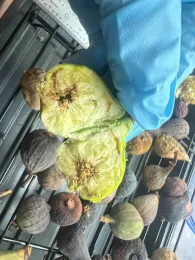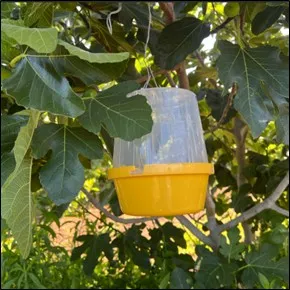PEST ALERT – Black Fig Fly
(Diptera: Lonchaeidae: Silba adipata)
Updated: October 2025
Invasive Fig Pest Initially Discovered in Southern California Has Now Spread to the Central Coast, Bay Area and Central Valley Regions

Black Fig Fly Infested Fruit
Overview: Fig growers need to be aware of the black fig fly (BFF), an invasive insect that was initially discovered infesting figs throughout southern California in 2021. Since then, the BFF has expanded into the Central Coast, Bay Area and Central Valley regions (Fig. 1). To date, BFF infestations have been reported in the following counties: Alameda, Contra Costa, Los Angeles, Merced, Orange, Riverside, San Benito, San Bernardino, San Diego, San Luis Obispo, San Mateo, Santa Barbara, Santa Clara, Santa Cruz, and Ventura. Movement of fig fruits and/or potted fig plants out of these counties is not recommended, as it may lead to additional artificial spread of BFF to other areas of the state. Personnel with University of California Cooperative Extension (UCCE) and UC Riverside are currently working with the California Department of Food and Agriculture to further monitor populations, as well as develop improved trapping and management strategies.

Black Fig Fly Laying Egg
Life Cycle: The BFF only attacks figs and prefers unripe unfertilized fruits. The adult female deposits eggs into the fruit through the ostiole and larvae subsequently feed internally on the fruit which creates tunnels and damaged flesh . This feeding causes the fruit to prematurely drop from the tree onto the ground. Upon completion of development, the BFF larvae make their way out of the fruit, drop to the ground and pupate in the soil. Black fig flies overwinter as pupae in the soil. In the spring they emerge, mate and begin to infest fig fruits. The BFF can have 4-6 generations per year depending on the region (more generations in warmer areas, fewer in cooler areas).

BFF Pupa on Soil
Monitoring: Fig fruits can be inspected for signs of BFF activity, such as larval feeding or exit holes. Focus on unripe fruits that have recently fallen from the tree. Populations of BFF adults can also be monitored using McPhail-type traps baited with torula yeast lures. For a single trap, combine 20 grams, or four tablets, of torula yeast with 400 ml of water and replace this solution every two weeks.

McPhail Trap Loaded with Torula Yeast Solution
Management Biological control of the BFF appears to be very limited. The only reported natural enemy is a generalist pupal parasitoid known to attack dozens of different hosts. Surveys to date in California have not revealed any additional parasitism. As such, orchard sanitation is critical, and growers should make sure to remove and destroy any BFF-infested fruits. Homeowners, hobby and/or small-scale producers have also found some success placing small mesh bags over individual fruits, or a larger mesh cage over the entire tree, to impede adult BFF access to the developing fruits. Similarly, since the BFF larvae pupate in the soil, plastic mulch under the tree canopy may impede this part of the life-cycle and lead to increased BFF mortality. Larvae in infested fruit are protected from pesticide sprays and there are no effective soil drenches for pupal control. Researchers are currently evaluating the use of insecticidal baits such as Entrust® or GF-120 NF Naturalyte® for control of adult BFF, but note that label rates have not been directly tested for efficacy against this pest. Consult with a licensed pest control adviser and your County Agricultural Commissioner before applying any chemical controls.
Please Do Not Move Figs: California figs are primarily grown in the Central Valley in Madera and Merced counties, with many smaller orchards spread across the state. Movement of fig fruits or potted fig plants out of the infested counties is not recommended, as it may lead to additional artificial spread of BFF to other areas of California.
Reporting the Pest/Contact Information: If you find infested fruit or suspect that BFF may be attacking fruits in your orchard or yard, please reach out to your local UC Cooperative Extension Farm Advisor (https://ucanr.edu/). If you suspect that you have a BFF infestation in a county not listed above, please report this to your County Agricultural Commissioner and the CDFA Pest Hotline: 1-800-491-1899 (https://www.cdfa.ca.gov/plant/reportapest/).
Authors: Houston Wilson (Dept. Entomology, UC Riverside), Mel Thayer (Dept. Entomology, UC Riverside), Phoebe Gordon (UC Cooperative Extension – Madera/Merced), and Ben Faber (UC Cooperative Extension – Ventura).

